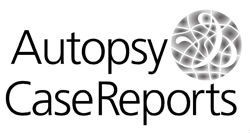A rare case of centronuclear myopathy with DNM2 mutation: genotype–phenotype correlation
Amir Ghorbani Aghbolaghi; Mirna Lechpammer
Abstract
Centronuclear myopathy (CNM) is a group of rare genetic muscle disorders characterized by muscle fibers with centrally located nuclei. The most common forms of CNM have been attributed to X-linked recessive mutations in the MTM1 gene; autosomal-dominant mutations in the DNM2 gene-encoding dynamin-2, the BIN1 gene; and autosomal-recessive mutations in BIN1, RYR1, and TTN genes. Dominant CNM due to DNM2 mutations usually follows a mild clinical course with the onset in adolescence. Currently, around 35 mutations of the DNM2 gene have been identified in CNM; however, the underlying molecular mechanism of DNM2 mutation in the pathology of CNM remains elusive, and the standard clinical characteristics have not yet been defined. Here, we describe the case of a 17-year-old female who presented with proximal muscle weakness along with congenital anomalous pulmonary venous connection (which has not been described in previous cases of CNM), scoliosis, and lung disease without a significant family history. Her creatine kinase level was normal. Histology, special stains, and electron microscope findings on her skeletal muscle biopsy showed CNM with the characteristic features of a DNM2 mutation, which was later confirmed by next-generation sequencing. This case expands the known clinical and pathological findings of CNM with DNM2 gene mutation.
Keywords
References
1. Spiro AJ, Shy GM, Gonatas NK. Myotubular myopathy: persistence of fetal muscle in an adolescent boy. Arch Neurol. 1966;14(1):1-14. PMid:4954227. http://dx.doi.org/10.1001/archneur.1966.00470070005001.
2. Fardeau M. Skeletal muscle pathology. In: Mastaglia FL, Walton Sir JN, editors. Congenital myopathies. London: Churchill Livingston; 1982. p. 161-203.
3. Fardeau M, Tome F. Congenital myopathies. In: Engel AG, Franzini-Armstrong C, editors. Myology. 2nd ed. New York: McGraw Hill; 1994. p. 1500-25.
4. North KN. Congenital myopathies. In: Engel A, Franzini-Armstrong C, editors. Myology. 3rd ed. New York: McGraw Hill; 2004. p. 1473-533.
5. Toussaint A, Cowling BS, Hnia K, et al. Defects in amphiphysin 2 (BIN1) and triads in several forms of centronuclear myopathies. Acta Neuropathol. 2011;121(2):253-66. PMid:20927630. http://dx.doi.org/10.1007/s00401-010-0754-2.
6. Bohm J, Biancalana V, DeChene ET, et al. Mutation spectrum in the large GTPase dynamin 2, and genotype–phenotype correlation in autosomal dominant centronuclear myopathy. Hum Mutat. 2012;33(6):949-59. PMid:22396310. http://dx.doi.org/10.1002/humu.22067.
7. Zanoteli E, Oliveira AS, Schmidt B, Gabbai AA. Centronuclear myopathy: clinical aspects of ten Brazilian patients with childhood onset. J Neurol Sci. 1998;158(1):76-82. PMid:9667782. http://dx.doi.org/10.1016/S0022-510X(98)00091-4.
8. Laporte J, Hu LJ, Kretz C, et al. A gene mutated in X-linked myotubular myopathy defines a new putative tyrosine phosphatase family conserved in yeast. Nat Genet. 1996;13(2):175-82. PMid:8640223. http://dx.doi.org/10.1038/ng0696-175.
9. Bartsch O, Kress W, Wagner A, Seemanova E. The novel contiguous gene syndrome of myotubular myopathy (MTM1), male hypogenitalism and deletion in Xq28: report of the first familial case. Cytogenet Cell Genet. 1999;85(3-4):310-4. PMid:10449925. http://dx.doi.org/10.1159/000015284.
10. Sutton IJ, Winer JB, Norman AN, Liechti-Gallati S, MacDonald F. Limb girdle and facial weakness in female carriers of X-linked myotubular myopathy mutations. Neurology. 2001;57(5):900-2. PMid:11552027. http://dx.doi.org/10.1212/WNL.57.5.900.
11. Bevilacqua JA, Bitoun M, Biancalana V, et al. “Necklace” fibers, a new histological marker of late-onset MTM1-related centronuclear myopathy. Acta Neuropathol. 2009;117(3):283-91. PMid:19084976. http://dx.doi.org/10.1007/s00401-008-0472-1.
12. Romero NB. Centronuclear myopathies: a widening concept. Neuromuscul Disord. 2010;20(4):223-8. PMid:20181480. http://dx.doi.org/10.1016/j.nmd.2010.01.014.
13. Pierson CR, Tomczak K, Agrawal P, Moghadaszadeh B, Beggs AH. X-linked myotubular and centronuclear myopathies. J Neuropathol Exp Neurol. 2005;64(7):555-64. PMid:16042307. http://dx.doi.org/10.1097/01.jnen.0000171653.17213.2e.
14. Nicot AS, Toussaint A, Tosch V, et al. Mutations in amphiphysin 2 (BIN1) disrupt interaction with dynamin 2 and cause autosomal recessive centronuclear myopathy. Nat Genet. 2007;39(9):1134-9. PMid:17676042. http://dx.doi.org/10.1038/ng2086.
15. Claeys KG, Maisonobe T, Böhm J, et al. Phenotype of a patient with recessive centronuclear myopathy and a novel BIN1 mutation. Neurology. 2010;74(6):519-21. PMid:20142620. http://dx.doi.org/10.1212/WNL.0b013e3181cef7f9.
16. Jungbluth H, Zhou H, Sewry CA, et al. Centronuclear myopathy due to a de novo dominant mutation in the skeletal muscle ryanodine receptor (RYR1) gene. Neuromuscul Disord. 2007;17(4):338-45. PMid:17376685. http://dx.doi.org/10.1016/j.nmd.2007.01.016.
17. Bevilacqua JA, Monnier N, Bitoun M, et al. Recessive RYR1 mutations cause unusual congenital myopathy with prominent nuclear internalisation and large areas of myofibrillar disorganisation. Neuropathol Appl Neurobiol. 2011;37(3):271-84. PMid:21062345. http://dx.doi.org/10.1111/j.1365-2990.2010.01149.x.
18. Ceyhan-Birsoy O, Agrawal PB, Hidalgo C, et al. Recessive truncating titin gene, TTN, mutations presenting as centronuclear myopathy. Neurology. 2013;81(14):1205-14. PMid:23975875. http://dx.doi.org/10.1212/WNL.0b013e3182a6ca62.
19. Jeannet PY, Bassez G, Eymard B, et al. Clinical and histologic findings in autosomal centronuclear myopathy. Neurology. 2004;62(9):1484-90. PMid:15136669. http://dx.doi.org/10.1212/01.WNL.0000124388.67003.56.
20. Bitoun M, Maugenre S, Jeannet P-Y, et al. Mutations in dynamin 2 cause dominant centronuclear myopathy. Nat Genet. 2005;37(11):1207-9. PMid:16227997. http://dx.doi.org/10.1038/ng1657.
21.National Center for Biotechnology Information – NCBI [cited 2016 Sept 26]. Available from: https://www.ncbi.nlm.nih.gov/clinvar/variation/7281/
Publication date:
06/29/2017

